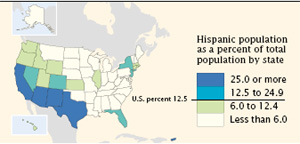|
|
|
 |
|
|
U.S.
Society > Hispanic Americans |
|
It is not uncommon to walk down the streets of an American city today and hear Spanish spoken. In 1950 fewer than 4 million U.S. residents were from Spanish-speaking countries. Today that number is about 45 million. About 50 percent of Hispanics in the United States have origins in Mexico. The other 50 percent come from a variety of countries, including El Salvador, the Dominican Republic, and Colombia. Thirty-six percent of the Hispanics in the United States live in California. Several other states have large Hispanic populations, including Texas, New York, Illinois, and Florida, where hundreds of thousands of Cubans fleeing the Castro regime have settled. There are so many Cuban Americans in Miami that the Miami Herald, the city's largest newspaper, publishes separate editions in English and Spanish. The term Hispanic was coined by the federal government in the 1970's to refer to the people who were born in any of the Spanish-speaking countries of the Americas or those who could trace their ancestry to Spain or former Spanish territories. Obviously, this represents a wide variety of countries and ethnic groups with different social, political and emotional experiences. Most Hispanics see themselves in terms of their individual ethnic identity, as Mexican American, Puerto Rican, Cuban, etc. instead of members of the larger, more ambiguous term Hispanic or Latino.
The Newcomers Myth |
|||
|
|||
| Texts
are abridged from U.S. State Department IIP
publications and other U.S. government materials. |
|||
| Feature Articles: | |||
Hispanics,
the Largest U.S. Minority, Enrich the American Mosaic.
By Louise Fenner U.S.
Minority Population Continues to Grow. By David Minckler Cinco
de Mayo Shows the Americanization of a Mexican Holiday.
By Lauren Monsen |
|||
DISCLAIMER
Any reference obtained from this server to a specific commercial product, process, or service does not constitute or imply an endorsement by the United States Government of the product, process, or service, or its producer or provider. The views and opinions expressed in any referenced document do not necessarily state or reflect those of the United States Government. |
 U.S. Diplomatic Mission to Germany /Public Affairs/ Information Resource Centers Updated: Octoberr 2010. |


 Hispanics
in U.S. Culture
Hispanics
in U.S. Culture